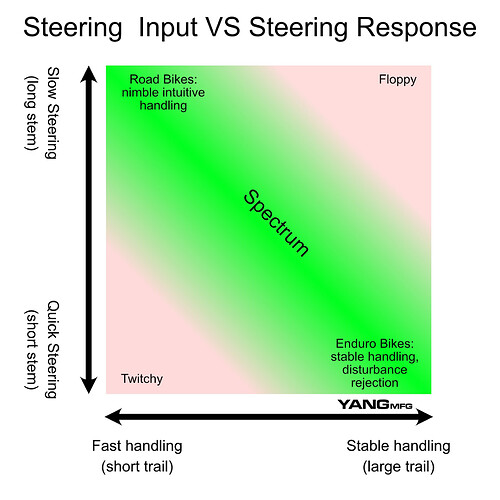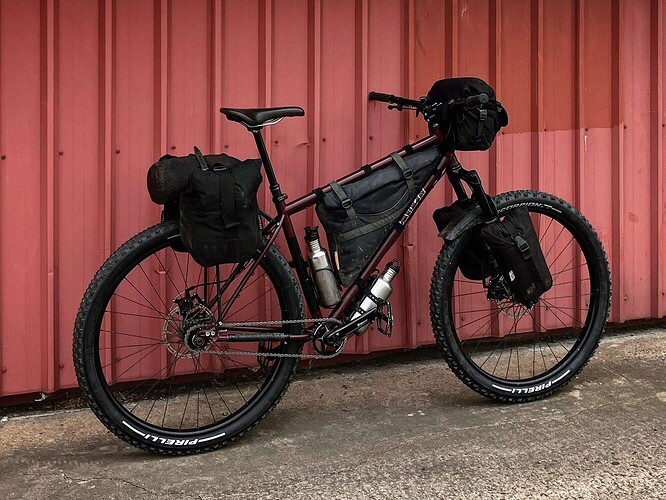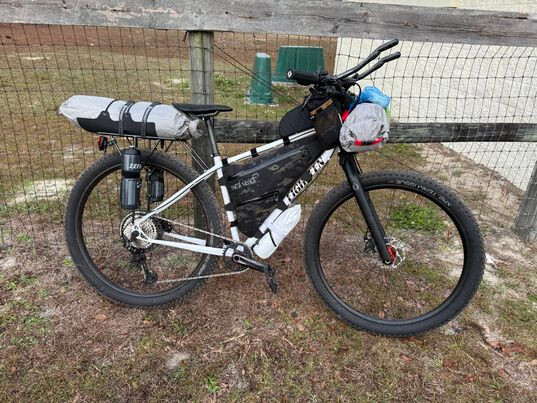I’m curious to hear about your thought process when designing a dedicated bikepacking bike. I’m interested in the fully-custom perspective but also interested in production runs where certain parameters might need to be adapted to fit more people.
“Bikepacking” is kind of a vague term that will mean different things to different people, depending on where they live and what they like to ride. In the end it always comes down to personal preferences, but that’s what I’m interested to know, what do you prefer and why. To me, a bikepacking bike will see a bit of everything: pavement, gravel, dirt roads, single tracks, unmaintained roads, etc. It is somewhat a tough compromise, because you want it to be stable and capable on technical terrain (I personally enjoy a little underbiking), but also not too overbuilt and slow on long paved sections. I also prefer bikes that can be loaded like a mule over fast and light machines made to carry only the very minimal. So here are a couple of design aspects that I’ve been tinkering about or that I see discussed often. I’d also be curious to hear about anything I missed obviously.
(Sorry for the long thread, these are thoughts and questions I have accumulated over a long period of time and preferred grouping them in the same thread rather than chasing answers through multiple discussions)
Front end geometry
I noticed bikepacking bikes generally tend to fall in two categories: more touring-like or more mtb-like. Touring-like tend to have lower trail numbers (60-80) while mtb-like can have moderate to high numbers (80 and up). For a bikepacking bike, I think it is important to consider the effect of the front load on handling and steering. From what I understand of it, a front load will tend to stabilize the steering when going straight, and requires more input when initiating steering, but will then accentuate the wheel flop effect while steering. Based on that, to me it seems more logical to go with a lower trail measurements since the front load will already help with stability. From my experience, my previous bike had a relatively low trail for that type of bike (low 60’s), and it did feel a little twitchy without a front load, but would feel very stable and nimble when front loaded, even on singletracks. My current bike (that I designed and built during my class with Dave Bohm) is very similar but with a little difference in the front end which results in a 80mm trail measurements, and it might be just a question of habit, but I do find it a bit slow to steer. Nothing drastic, but enough that I notice a difference and a preference for how my old one handled. So, unless you are going for very singletrack-heavy bikepacking, is there any reason to favour longer trail measurements?
Chainstay length
The eternal debate about chainstay length… Just like I mentioned about front-end geometry, some bikes a more touring-like with plenty long chainstays while other are more akin to mtb and keeping the chainstays as short as possible. Most of what I hear about long vs short (in mtb at least) is about climbing, cornering and endo angle. I must say I can’t really figure out how all this ties up with a loaded bikepacking bike. I mostly rode long-chainstays bike and never really noticed any difficulties relating to climbing and cornering. I would tend to think how you load the bike would also play an important part (more front biased vs rear biased).
Chainring/tire clearance
I’ve heard a common design issue that comes up with bikepacking bike is the clearance for the chainring and rear tire, where we often want relatively large tires (at least 2”) but chainring generally bigger than mtb (36t and up), which creates a lot of interference. There are various solutions to this I believe, such as yokes/half-yokes, plates and custom-bent stays. Any advantage or disadvantage to any of these, in terms of stiffness or manufacturing efficiency? I have been told that plates generally have poor property compared to yokes but yokes are generally considerably more expensive. If I’m not mistaken the choice of bottom bracket shell and rear hub spacing will also have an impact, although I can’t say I see how they all play together.
Reach, Flat bar vs drop bar
When it comes to off-road oriented bikes, I think most people will agree that the front-end should be as long as possible for added stability and avoid toe-overlap. In that case, the reach of the frame will likely be based on whether it’s intended for drop bars or flat bars. One thing that I’ve noticed tho, is that many off-the-shelf dropbar bikepacker seem to come stock with a 80mm stem (eyeballing here…), which I would consider to be relatively long, while plenty of options exist in the 35-50mm range. My initial thought is, why base a frame reach around a 80mm stem when you could lengthen the front end and use a 50mm stem? I understand that for a production frame you want to leave some room for people with arms shorter than average, but going from 80 to 35 seems like a lot of wiggle room to me (we even have 30mm and 0mm stems around now thanks to Tanglefoot). Even with a custom made frame, are there any reason not to go with the shortest stem possible when running drop bars? I didn’t mention anything about how stem length affects steering because it is not something that I personally understand and that I know is somewhat of a “controversial” topic that would likely need it’s own thread (but I’m always interested to hear your thoughts).
Looking forward to hear anything I’m missing!



